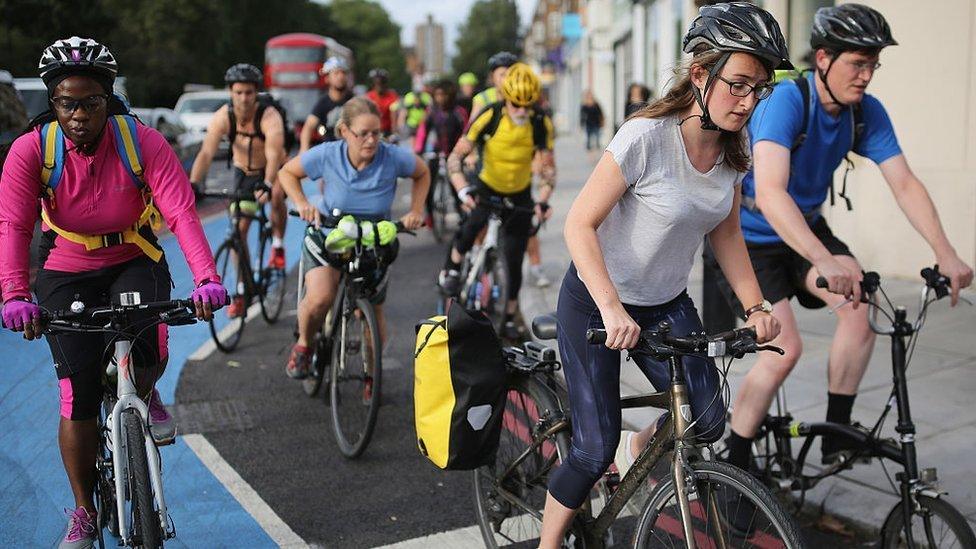How dangerous are Toronto streets for the city's cyclists?
- Published
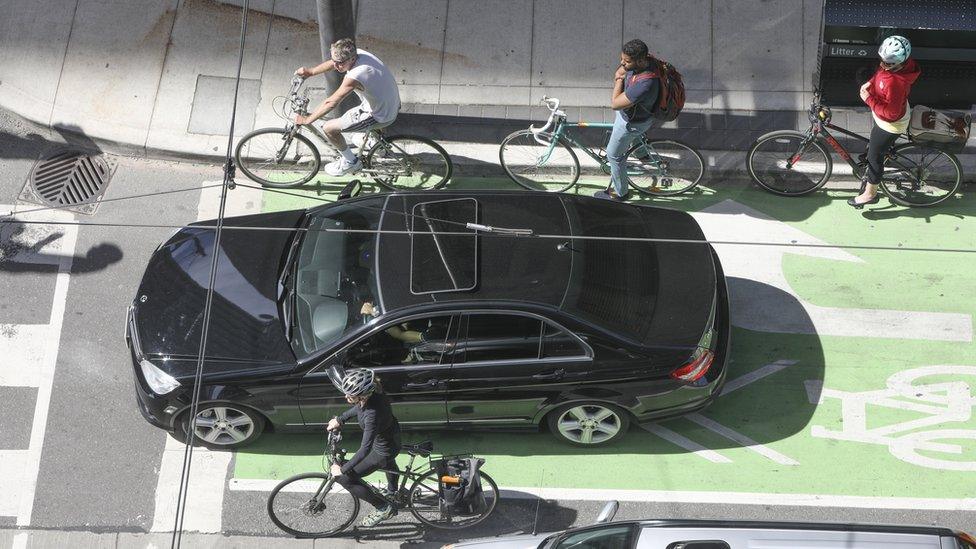
Confusion reigns at some Toronto intersections
Cyclists in Toronto are raising concerns about the risks of riding bikes following a rash of deaths this summer. How dangerous is it to saddle up in Canada's largest city?
Henry Gold has cycled in over 80 countries.
That experience has led the 66-year-old biking enthusiast to a controversial opinion - that Toronto is the most perilous city in the world to be a cyclist.
"If you have to - for any length of time - cycle on any of the major arteries in Toronto, it's more dangerous than anywhere else in the world," he says.
That claim may have people raising a sceptical eyebrow, though a string of cycling and pedestrian deaths over a short period of time in Toronto has raised road safety concerns in Canada's largest city.
Three cyclists died in a month-long span on the city's streets in May and June. A fourth cyclist died in March in a collision with a parked car.

Geoffrey Bercarich paints and maintains ghost bike memorials in the city
Cycling advocates in the city have organised so-called "ghost bike rides" and have set up memorials to mark the spot a cyclist was killed with white painted bike frames.
"I see them as lighthouses depicting dangerous waters around the streets," Geoffrey Bercarich, who helps maintain the memorials, told the BBC.
In late June, city council responded to concerns by approving an additional C$22m ($16.7m; £12.6m) for the Vision Zero programme, a five-year plan with the goal of reducing traffic-related deaths and injuries to nil.
Vision Zero has so far been panned as a failure, external.
Mr Gold, who founded a company that runs cycling tours around the world, says the city's speed limits - between 50 km/h to 60km/h (31mph to 37mph) on most major roads and arteries - are to blame for the danger.
People don't die when cars move at a crawl, he contends.
"The wonderful thing about traffic jams is no one gets killed."
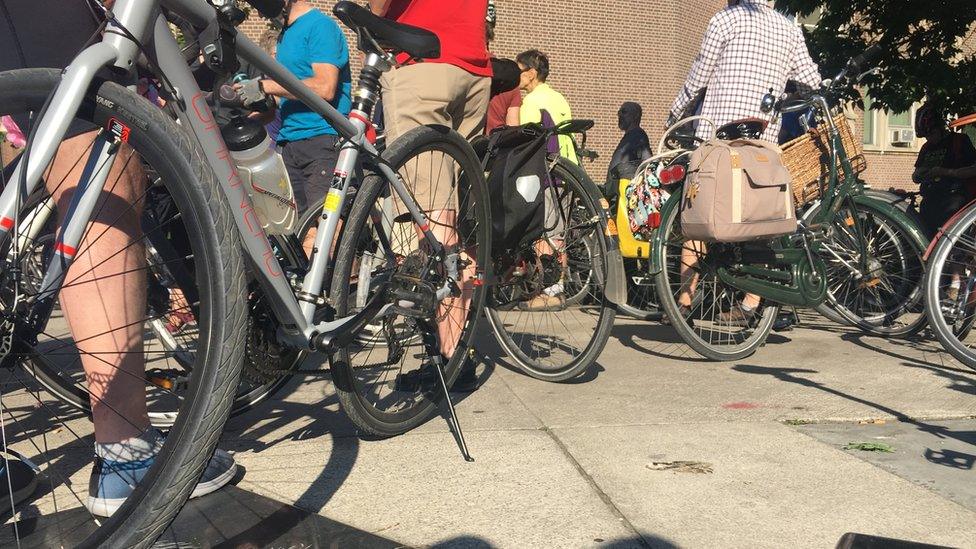
Cyclists gather in Toronto for a ghost bike ride
But traffic jams are what many Toronto commuters dread.
The fourth largest North American city's population is having a growth spurt, which has left drivers, streetcars, cyclists, and pedestrians competing for street space.
In June, Expert Market, a UK-based business solutions firm, released a report , externalsuggesting Toronto had the worst commute times in North America.
It ranked globally slightly above Istanbul and slightly below London, based on factors like average commute times and distances.
The crowded roads and long commutes have created political tension between avid cyclists who feel threatened by cars and drivers who have expressed frustration at cyclists.
Former Toronto Mayor Rob Ford helped heat up the debate when he made ending the "war on the car" in Toronto a campaign catchphrase in 2010.

Late Toronto mayor Rob Ford said there was a "war on cars" in the city
He found support from a number of city councillors, especially those representing suburban wards whose voter base were made up of car commuters.
During his time in office, Toronto removed some of the city's bike lanes.
Opponents to bike infrastructure feared increased traffic congestion and reduced parking spaces. Merchants fretted over possible lost business.
Some criticised spending money on permanent separated cycle lanes in a city where only the hardiest cyclists venture out on their bikes during winter months.
Toronto is far from the only city where the car versus bike debate has raged - it's cropped up in places like London, Seattle, Los Angeles, Vancouver, New York City, Chicago, and Washington, DC.
It's been an issue in Montreal, which is considered one of the most bike-friendly cities in North America.
Kay Teschke, a University of British Columbia professor who studies urban cycling, says a good cycling city is one that includes space for people on bikes on the road, like a comprehensive network of cycling paths on major roads and arteries that physically separate cars and bikes.
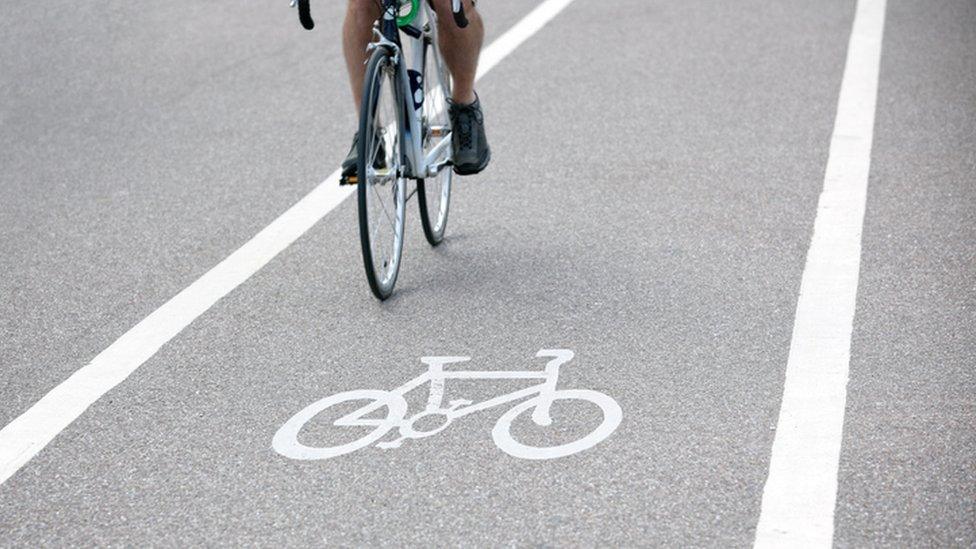
"It just makes no sense for vehicles with such different masses and velocities to be put together," she says.
"Anyone who makes any kind of mistake is waiting for a catastrophe to happen."
Toronto has turned a corner since the height of Rob Ford's "war on car" days, and has been adding to the city cycling infrastructure.
In 2017, city council approved a permanent separated bike lane on one of the major east-west connections with little opposition.
City bureaucrats found the Bloor bike lane both encouraged ridership and reduced collisions between cars and bikes, though it did slow commute times for cars by just over four minutes in some cases.
A recent poll indicated, external that almost half of Torontonians supported more separated cycle lanes being added.
Ms Teschke says drivers and cyclists alike appreciate the security and consistency of separated bike paths. Separated lanes also keep cyclists away from Toronto's metal streetcar tracks, which can be slippery and are the perfect size to catch an errant tire.
One study, external found that a third of cycling accidents were directly linked to the tracks.

Streetcars are traditional vehicles typical of Toronto
Ms Teschke says that while Toronto has made strides towards becoming a cycling city, like a number of places it suffers from having "a huge jumble" of different ways that transportation for bikes, cars, pedestrians and public transit are managed across the city.
"If a city has a consistent treatment of where cyclists ride, everyone understands better what's going on - it's more intuitive what to do," she says.
"But in North America at the moment we have every combination for cyclists."
So how does Toronto objectively compare to other cities around the world for bike safety?
There's no clear answer, since it can be difficult to get a perfect comparison between cities, which compile statistics in different ways.
In 2015, the Pembina Institute published a report, external that looked at the crash rate per 100,000 cycling trips. Toronto had five, the highest of five Canadian cities. Montreal and Vancouver tied as the safest cities, with two collisions per 100,000 trips.
Statistics compiled by Toronto, external suggest that compared to the top 10 largest North American cities, the city's road fatality rate - including drivers, cyclists and pedestrians - is among the lowest, higher than Chicago and New York but lower than Phoenix, Philadelphia and Los Angeles.
- Published3 May 2012
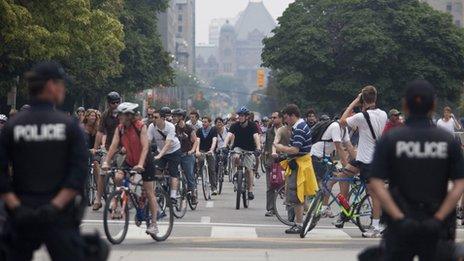
- Published21 September 2017

- Published12 June 2018
